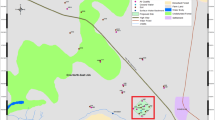Abstract
The development of regulations patterned after the United States’ requirement for maximum achievable control technology (MACT) to control hazardous air pollutants from major industrial sources in Korea is in progress. Current management practices and installed air pollution control devices were surveyed; emission tests and continuous emission data collected from facilities under operation were assessed considering other MACT requirements such as reporting, report keeping requirements. Emission sampling and air pollutant analysis were carried out at representative hazardous waste incinerators installed with wet-type and dry-type air pollution control devices. Korean and United States Environmental Protection Agency methods were used for sampling and analysis. The major heavy metals emitted were Zn, Ni, Pb, and Cr. The heavy metal removal efficiency of existing air pollution control devices was greater than 99%. The average mercury removal efficiency was more than 30%. Toluene; m,p-xylene; o-xylene; benzene; dichloromethane; styrene; ethylbenzene; 1,3-dichlorobenzene; and 1,2,4-trimethylbenzene were the major volatile organic compounds emitted. The emissions from field tests were compared, reviewed, and analyzed with respect to MACT regulations to check applicability. Finally, draft guidelines were suggested for effective hazardous air pollutant management in Korea.
Similar content being viewed by others
References
Ministry of Environment, Korea (2001–2006) The status of operation of large-scale municipal solid waste incinerators. http://www. me.go.kr, (accessed May 2007)
Jang HN, Seo YC, Lee JH, Kim JH, Pudasainee D, Park JM, Song KJ, Mun YH, Park KS (2007) Implementation of US MACT regulation to Korean municipal waste incinerators. J Korea Soc Waste Manag 12(1):31–35
Ministry of Environment, Korea, The rule of air protection. http://eng.me.go.kr/docs/laws/laws.html?topmenu=D&cat=400, (accessed May 2007)
Ministry of Environment, Korea, The rule of waste management. http://www.me.go.kr, (accessed May 2007)
Ministry Environment, Korea, Air pollutant emissions trading system. http://eng.me.go.kr/docs/sub2/policy_view.html?topmenu=C&cat=210&class=10 (accessed May 2007)
USEPA (2005) http://www.epa.gov/epaoswer/hazwaste/hazcmbst.htm (accessed September 2007)
USEPA (2005) CFR 40 part 63 subpart EEE. National emission standards for hazardous air pollutants (NESHAPs) from hazardous waste combustors. The Agency, Washington, DC
Wey MY, Su JL, Yan MH, Wei MC (1998) The concentration distribution of heavy metals under different incineration operation conditions. Sci Total Environ 212:183–193
Laudal DL, Brown TD, Nott BR (2000) Effects of flue gas constituents on mercury speciation. Fuel Process Technol 65–66: 157–165
Chang MB, Huang CK, Wu HT, Lin JJ, Chang SH (2000) Characteristics of heavy metals on particles with different sizes from municipal solid waste incineration. J Hazard Mater 79:229–239
Song GJ, Kim KH, Seo YC, Kim SC (2004) Characteristics of ashes from different locations at a MSW incinerator equipped with various air pollution control devices. Waste Manag 24:99–106
Park KS, Jang HN, Lee JH, Lee SH, Seo YC (2006) Speciation and mass distribution of mercury emitted from waste incinerators and cement kilns. Fourth i-CIPEC, September 26–29, 2006, Kyoto, Japan
Ruth LA (1998) Energy from municipal solid waste: a comparison with coal combustion technology. Prog Energy Combust Sci 24:545–564
Lee SJ, Seo YC, Jang HN, Park KS, Baek JI, An H-S, Song KC (2006) Speciation and mass distribution of mercury in a bituminous coal-fired power plant. Atmos Environ 40:2215–2224
Pavlish JH, Sondreal EA, Mann DM, Oslin ES, Galbreath KC, Laudel DL, Benson SA (2003) Status review of mercury control options for coal-fired power plants. Fuel Process Technol 82:89–165
Park KS, Seo YC, Lee SJ, Lee JH (2008) Emission and speciation of mercury from various combustion sources. Powder Technol 180:151–156
Author information
Authors and Affiliations
Corresponding author
Rights and permissions
About this article
Cite this article
Kim, JH., Seo, YC., Pudasainee, D. et al. Efforts to develop regulations in Korea similar to the US maximum achievable control technology (MACT) regulations for hazardous waste incinerators. J Mater Cycles Waste Manag 11, 183–190 (2009). https://doi.org/10.1007/s10163-008-0247-8
Received:
Accepted:
Published:
Issue Date:
DOI: https://doi.org/10.1007/s10163-008-0247-8




